Medical expert of the article
New publications
Preparations
Knee pain pills
Last reviewed: 03.07.2025

All iLive content is medically reviewed or fact checked to ensure as much factual accuracy as possible.
We have strict sourcing guidelines and only link to reputable media sites, academic research institutions and, whenever possible, medically peer reviewed studies. Note that the numbers in parentheses ([1], [2], etc.) are clickable links to these studies.
If you feel that any of our content is inaccurate, out-of-date, or otherwise questionable, please select it and press Ctrl + Enter.
Various means are used to treat knee pain, but tablets deserve special attention. Consider their types, names, medicinal properties and application features.
Knee joints are the most vulnerable joints, as they have a complex structure and are under constant load. Orthopedists and traumatologists most often encounter complaints of knee pain when straightening, walking or at rest. Before starting treatment, the patient is sent for X-ray examinations and other diagnostic methods to identify the root cause of the pathological condition.
Knee pain pills are used for joint pathologies. The drugs can be prescribed in stages. The following types of medications are most often prescribed for treatment:
- Nonsteroidal anti-inflammatory drugs
Prescribed to adult patients, as they have side effects on the duodenum and stomach. These organs suffer greatly with prolonged use of NSAIDs. Effective not only for pain, but also for pathological processes in the joint. Most often prescribed: Diclofenac, Paracetamol, Indomethacin, Ibuprofen, Nimesulide, Meloxicam, Celecoxib.
- Non-narcotic analgesics
The use of these drugs will help eliminate painful sensations with minimal harm to other organs and systems. Moderate pain-relieving effect is provided by: Analgin, Sulpirine. More powerful action is provided by drugs with the active component ketorolac: Ketanov, Ketoprofen, Ketolong. For severe pain, tablets with dexketoprofen are used. Strong non-narcotic analgesics are prescribed to patients with severe pain, but such medications are expensive: Xefocam, Larfix and other tablets with lornoxicam.
- Narcotic analgesics
If drugs of other pharmacological groups are ineffective, then the patient is prescribed narcotic analgesics. In order to prevent addiction, short-term therapy is carried out, combining with non-narcotic analgesics and NSAIDs. Most drugs of this group are produced in the form of injections, but there are also tablets: Tramadol, Promedol.
- Opioid drugs
They act on opioid receptors in the brain, are not addictive and are not psychotropic. Their effectiveness is similar to that of narcotic analgesics. They are expensive and are available only with a doctor's prescription: Nalbuphine.
Medicines can only be taken as prescribed by a doctor. Self-administration of drugs causes temporary pain relief. But without proper treatment, discomfort quickly returns with renewed vigor.
Indications for use
The use of any drugs to relieve painful sensations in the joints is recommended to be taken only as prescribed by a doctor. The doctor conducts a number of diagnostic procedures and, based on their results, gives indications for the use of certain drugs.
Algorithm for using medications to relieve knee pain:
- Painkillers are prescribed according to the principle from weak to strong. Exceptions are possible in case of severe pain syndrome.
- To treat severe pain, blockades are performed with injection or local anesthetics. It is advisable to take tablets before and after the above manipulations to achieve a more lasting pain-relieving effect.
- For acute pain of inflammatory or traumatic nature, NSAIDs are taken. For chronic pain, non-narcotic/narcotic analgesics, muscle relaxants, glucocorticoids are used. In addition, periarticular and intraarticular blockades are indicated.
The tablets are prescribed for both mild injuries (bruises, meniscopathy, synovitis) and more serious pathologies (osteoporosis, arthritis, bursitis, inflammatory diseases, joint blockade, penetrating infections).
Pharmacodynamics
Biochemical and physiological properties of drugs determine their effectiveness. Pharmacodynamics allows you to learn how active components act on certain harmful microorganisms and pathological processes. Let's consider the pharmacodynamics of popular groups of tablets for knee pain.
- NSAIDs
Ibuprofen – has analgesic, anti-inflammatory and antipyretic properties. Pain relief occurs due to the suppression of prostaglandin biosynthesis through inhibition of the cyclooxygenase enzyme.
- Non-narcotic analgesics
Xefocam is a drug with analgesic and anti-inflammatory action. Inhibits the synthesis of prostaglandins by inhibiting the activity of cyclooxygenase isoenzymes. Inhibits the release of leukocytes of combined radicals. The analgesic effect is not associated with the narcotic effect on the central nervous system. Does not affect respiratory functions and opioid receptors, does not cause addiction and withdrawal syndrome.
- Narcotic analgesics
Morphine is an analgesic, an opioid receptor agonist. Reduces the emotional assessment of pain sensations due to the suppression of pain impulses in the central nervous system. Inhibits conditioned reflexes, excitability of the cough center. Increases the tone of smooth muscles of internal organs, increases intestinal peristalsis.
- Opioid
Tramal is a synthetic analogue of opiates, a derivative of phenanthrene. It has a mixed mechanism of action, since its active substance binds to opiate receptors in the central, middle and posterior regions of the spinal cord. Reduces the excitability of the pain center, minimizes the negative emotional coloring of discomfort. Blocks the flow of calcium ions into the cell, due to which the release of pain mediators, norepinephrine, is delayed.
- Chondroprotectors
Chondroitin – affects phosphorus-calcium metabolism in cartilage tissue. Stops bone resorption and cartilage degeneration. Prevents compression of connective tissue, acts as a lubricant for joint surfaces. Stimulates regeneration of articular cartilage, restores metabolism of hyaline tissue.
Pharmacokinetics
Since tablets are intended for oral use, the processes of absorption, absorption, metabolism and excretion are very important. Pharmacokinetics of drugs for the treatment of joints:
- NSAIDs
Ibuprofen - after oral administration, it is quickly and completely absorbed from the gastrointestinal tract. The maximum concentration in plasma occurs 2 hours after administration, in synovial fluid after 3 hours. It is metabolized in the liver, excreted by the kidneys in the form of conjugates, the half-life is 1.5-2 hours.
- Non-narcotic analgesics
Xefocam is absorbed from the gastrointestinal tract, the maximum concentration in plasma occurs after 1-2 hours. Bioavailability is 90-100%, binding to the albumin fraction of proteins is 99%. The active substance has no pharmacological activity and is not subject to metabolism. In blood plasma, it is present in an active form. The half-life depends on the concentration of the drug and is on average 4 hours. It is excreted in urine and bile.
- Narcotic analgesics
Morphine is rapidly absorbed, plasma protein binding is low – 35%. It penetrates the placental and BBB barriers, and is excreted in breast milk. During metabolism, it forms sulfates and glucuronides. It is excreted by the kidneys, about 12% during the day unchanged and 80% in the form of glucuronides, the remaining 10% with bile.
- Opioid
Tramadol – therapeutic doses do not affect the blood circulation process. The analgesic effect is 7.5 times weaker than that of Morphine. It has sedative properties, is addictive, and excites the vomiting center. It has little effect on intestinal peristalsis. The effectiveness lasts for 9 hours.
- Chondroprotectors
Chondroitin - the maximum concentration in the blood plasma is observed after 3-4 hours, and in the synovial fluid within 4-5 hours. Bioavailability is at the level of 13%. Metabolized in the liver, excreted by the kidneys during the day.
Tablets for knee joint pain
Joint pain occurs for various reasons: injuries, diseases. However, they do not always indicate the development of arthritis or arthrosis. Any lesions can cause discomfort: infectious, endocrine, colds, inflammatory. If unpleasant sensations appear regularly and are increasing in nature, then it is necessary to seek medical help, undergo an examination and identify the cause of the pathological condition.
To relieve joint pain, nonsteroidal anti-inflammatory drugs and chondroprotectors are most often used, not analgesics. Let's take a closer look at the tablets for joint pain in the knees:
- Chondroprotectors
Protect joints from destruction by affecting cartilage tissue. Their activity is based on restorative and barrier functions, nutritional and moisturizing action. Since cartilage begins to deteriorate due to drying out, chondroprotectors provide useful elements for its normal functioning, preventing joint pain.
Most often, patients are prescribed: Artra, Structum, Teraflex. These drugs are well tolerated, have a minimum of contraindications and side effects. But do not forget that oral forms of drugs have low efficiency, since some of the active components are lost in the process of metabolic transformations, unlike injections and topical agents.
- Non-narcotic analgesics
Eliminate excruciating joint pain, regardless of its cause. They are the main group of painkillers for knee joint damage. As a rule, patients are prescribed: Metamizole, Ketorolac, Lornoxicam, Acetylsalicylic acid.
- NSAIDs
They relieve joint pain in the knees and affect the pathogenetic links in many pathologies of the articular apparatus. The most common medications are: Diclofenac, Meloxicam, Nimesulide. These medications are most effective for pain of inflammatory origin.
- Combination drugs
Joint pain can arise from various pathogenetic reactions. Most often, these are inflammation, muscle spasms, destruction of bones and articular cartilage. To eliminate them, it is necessary to use combined medications from different drug groups:
- Tizalud, Mydocalm, Sirdalud – relieve tension and muscle spasms.
- Medrol, Methylprednisolone are glucocorticosteroid hormones.
- Renalgan, Spazmalgon, Baralgetas are NSAIDs of combined action with myotropic antispasmodics.
The correct approach to choosing painkillers speeds up the recovery process and minimizes discomfort.
Names of pills for knee pain
Knee pain is the most common reason for visiting traumatologists, surgeons and orthopedists. To eliminate discomfort, drugs of different forms are used. Let's consider the popular names of tablets for knee pain and the features of their use:
Nonsteroidal anti-inflammatory drugs
Diclofenac
It has anti-inflammatory, antipyretic and analgesic effects. Its effectiveness is based on the inhibition of cyclooxygenase 1 and 2, disruption of arachidonic acid metabolism and reduction of prostaglandins in the inflammatory focus. It has analgesic and anti-inflammatory effects in rheumatic pain, morning stiffness, joint swelling, and in the postoperative period.

After oral administration, it is quickly and completely absorbed. Food intake slows down the absorption process by 1-4 hours and reduces the concentration of active components by 40%. Bioavailability is 50%, plasma protein binding is 99%. Penetrates into synovial fluid, metabolized during the first pass through the liver.
- Indications for use: musculoskeletal system pathologies (arthritis, rheumatic tissue lesions, osteoarthrosis, bursitis, tendovaginitis), mild to moderate pain syndrome, post-traumatic and post-operative pain. Complex therapy of infectious and inflammatory diseases (throat, nose, ear) with severe pain syndrome, fever.
- Contraindications: acute stages of erosive and ulcerative lesions of the gastrointestinal tract, disorders of hematopoiesis and hemostasis, pregnancy and lactation, patients under 6 years of age, hypersensitivity to active substances. Use with particular caution in case of anemia, bronchial asthma, renal or hepatic insufficiency, in old age and in case of systemic lesions of connective tissue.
- The dosage is individual for each patient. The tablets are taken orally with water. For children aged 6-12 years, 1 tablet per day is prescribed, for patients aged 12 years and older, 2 tablets per day. The duration of therapy depends on its results in the first days of treatment. In case of overdose, adverse symptoms appear: vomiting, nausea, headaches and dizziness, convulsions, bleeding. To eliminate them, it is recommended to perform gastric lavage and forced diuresis.
- In some cases, side effects occur, which manifest as: flatulence, nausea, constipation, abdominal pain, dry mucous membranes. Headaches, aseptic meningitis, convulsions, disorientation, anxiety, general weakness are possible. In 1% of patients, disorders of the genitourinary system, hematopoietic organs and skin allergic reactions occur.
 [ 6 ], [ 7 ], [ 8 ], [ 9 ], [ 10 ]
[ 6 ], [ 7 ], [ 8 ], [ 9 ], [ 10 ]
Indomethacin
One of the most active non-steroidal anti-inflammatory drugs. Prostaglandin biosynthesis inhibitor, has a pronounced analgesic effect. The drug is prescribed for the following pathologies: rheumatoid arthritis, periarthritis, osteoarthrosis, inflammation of connective tissue, thrombophlebitis, nephrotic syndrome.
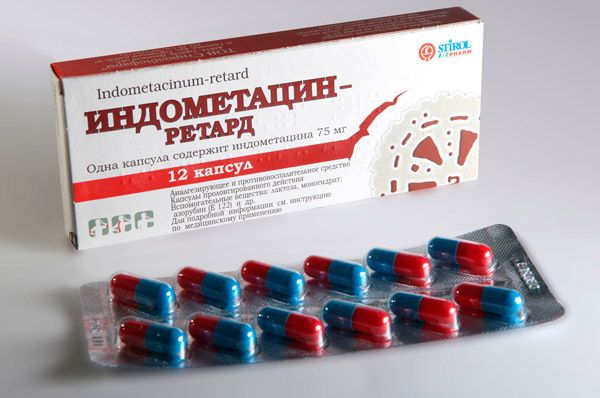
Effective not only for knee pain, but also for neuralgia, back pain, and rheumatism.
- Indomethacin is taken orally, after meals. The initial dosage is 25 mg 2-3 times a day, the maximum is 200 mg. The duration of treatment is 3-4 weeks with a gradual reduction in dosage to prevent withdrawal syndrome.
- Contraindications: ulcer of the duodenum and stomach, ulcerative processes in the esophagus and intestines. Bronchial asthma, pregnancy and breastfeeding. With special caution, prescribe to patients whose work is related to driving vehicles and other mechanisms.
- Side effects: drowsiness, headaches and dizziness, nausea, vomiting, loss of appetite, flatulence. In rare cases, gastrointestinal bleeding, indigestion, allergic reactions on the skin are observed.
Meloxicam
NSAID from the oxicam group, inhibits the cyclooxygenase-2 isoenzyme, providing analgesic and anti-inflammatory action. After oral administration, it is completely absorbed in the digestive tract. The maximum concentration is achieved in 5-6 hours.
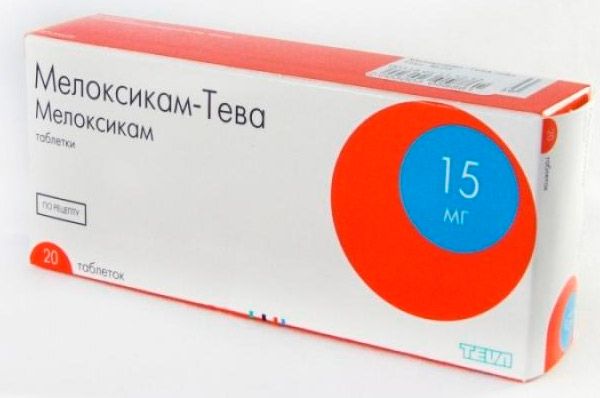
With regular use for 5-6 days, an equilibrium state develops. Food intake does not affect absorption and metabolism.
- Indications for use: symptomatic treatment of exacerbations of arthrosis, polyarthritis, ankylosing spondylitis, rheumatoid arthritis. Contraindicated in ulcerative lesions of the digestive system, intolerance to active components, gastrointestinal bleeding, during pregnancy and lactation, severe renal and hepatic insufficiency and for patients under 15 years of age.
- The tablets are taken once a day during meals with water. The duration of treatment is determined by the attending physician. In case of overdose, nausea and vomiting attacks, drowsiness, and abdominal pain occur. Gastric bleeding, increased blood pressure, respiratory depression, convulsions, and collapse may develop. Symptomatic and supportive therapy is indicated for the treatment of overdose.
- Side effects: leukopenia, anemia, decreased visual acuity, headaches, tinnitus, dizziness. From the digestive tract, pain in the epigastric region, nausea, vomiting, diarrhea, stomatitis, perforation of the walls of the digestive tract appear. Respiratory failure, skin allergic reactions, and genitourinary system disorders are also possible.
Non-narcotic analgesics
Analgin
A drug with pronounced analgesic, antipyretic and anti-inflammatory properties. After oral administration, it is quickly absorbed and has a medicinal effect.
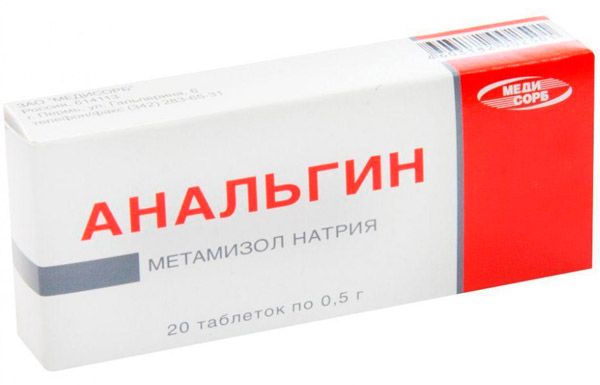
It is used to relieve pain of various origins: joint pain, headaches, feverish conditions, rheumatism, neuralgia.
- The tablets are taken after meals. For adults, the dosage is 250-500 mg 2-3 times a day, for children 5-10 mg/kg of body weight 3-4 times a day.
- Contraindicated in case of intolerance to the active substance, hematopoiesis disorders, bronchospasms.
- Side effects: long-term therapy causes suppression of hematopoiesis, therefore medical monitoring of the patient's condition and periodic blood tests are required.
Ketanov
A medicinal product with the active substance ketorolac. Inhibits prostaglandin biosynthesis, affects the cyclooxygenase pathway of arachidonic acid metabolism. Has anti-inflammatory and analgesic properties.
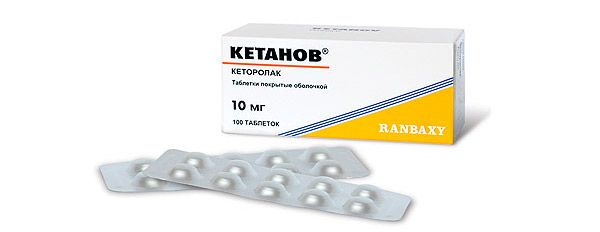
Inhibits platelet aggregation, does not affect ATP-induced platelet aggregation. Does not depress the respiratory centers and does not cause an increase in RSO, does not affect the heart muscle, does not cause hemodynamic disorders. The tablets do not affect psychomotor functions.
- Indications for use: elimination of moderate and severe pain of orthopedic, dental, otolaryngological, gynecological nature. Helps to minimize discomfort in acute muscle injuries, bone and soft tissue damage, sprains, fractures, dislocations.
- To achieve an analgesic effect, take 1 capsule every 4-6 hours. The duration of therapy should not exceed 7 days. For patients weighing less than 50 kg, over 65 years old and with impaired renal function, minimal dosages are indicated.
- Contraindications: pregnancy, breastfeeding, nasal polyposis, bronchial asthma, gastric ulcer and duodenal ulcer, intolerance to ketorolac tromethamine, blood clotting disorders, patients under 16 years of age.
- Overdose symptoms and side effects are similar. Most often, patients experience attacks of drowsiness, abdominal pain, nausea, diarrhea, headaches. Increased nervousness, dry mouth, increased sweating, increased heart rate, asthenia are possible.
Xefocam
An analgesic with anti-inflammatory properties. Its effectiveness is due to the suppression of prostaglandin synthesis through inhibition of cyclooxygenase isoenzyme activity. Does not affect opioid receptors of the central nervous system, the analgesic effect is not associated with narcotic effects.
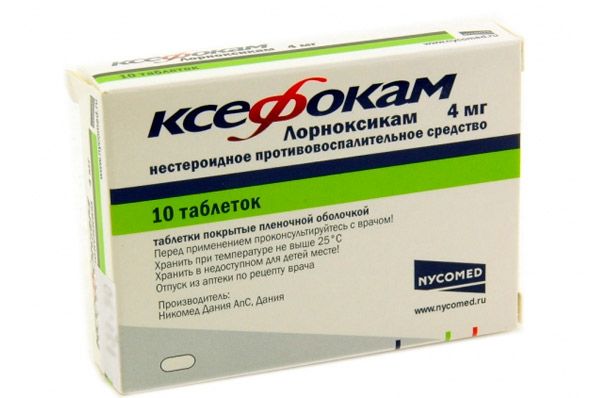
Does not cause addiction or withdrawal syndrome. When taken orally, it is almost completely absorbed from the gastrointestinal tract. The maximum concentration is observed after 1-2 hours, bioavailability is 90-100%, binding to plasma proteins is 99%.
- Indications for use: moderate and mild pain syndrome, degenerative and inflammatory diseases of the musculoskeletal system, acute pain, injuries, postoperative period.
- Contraindications: intolerance to NSAIDs and lornoxicam, blood clotting and liver function disorders, acute ulcers of the duodenum and stomach, ulcerative colitis, heart failure, hearing loss, hemorrhagic stroke, bronchial asthma, patients under 18 years of age.
- Tablets are taken before meals with water. The average dosage is 8-20 mg 2-3 times a day. The duration of treatment depends on the severity of the pain syndrome. In case of overdose, disorders occur in many organs and systems that are similar to side effects: nausea, vomiting, drowsiness, dizziness, allergic reactions. Symptomatic therapy and enterosorbents are used to eliminate them.
Narcotic analgesics
Tramadol
A drug with pronounced analgesic activity of long action. It is used for acute and chronic pain: in case of injuries, in the postoperative period, before operations, in oncological diseases.
- As a rule, take 50 mg, i.e. up to 8 capsules per day with a 2-hour break. Increased dosages can provoke a number of side effects. Most often, patients experience severe respiratory depression, gastrointestinal disorders, increased sweating, headaches. To eliminate them, you need to consult a doctor to adjust the dose.
- Contraindications: hypersensitivity to narcotic analgesics, alcohol intoxication, pregnancy and lactation, patient under 14 years of age. Long-term use causes addiction and weakening of the therapeutic effect.
Promedol
A powerful analgesic, affects the central nervous system, similar to morphine. Prescribed to patients with diseases and injuries that are accompanied by severe pain. Effective in the post- and preoperative period, in malignant neoplasms, angina, for pain relief during labor.
- Take 250 mg once a day (can be divided into several doses). The maximum daily dose is 500 mg. Long-term use of the drug can lead to the development of drug addiction.
- Contraindications: old age and childhood, severe exhaustion of the body.
- Side effects: respiratory depression, nausea, vomiting, diarrhea/constipation. To eliminate them, anticholinergic drugs are prescribed.
Opioid
Nalbuphine
A narcotic analgesic from the pharmacological group of opioid receptor agonists-antagonists. Its action is based on the disruption of interneuronal transmission of pain impulses at different levels of the central nervous system. This occurs due to the effect on the brain. It inhibits conditioned reflexes, has a sedative effect, and excites the vomiting center. The medicinal effect when taken orally develops within 1-2 hours and lasts for 5-6 hours.
- Indications for use: treatment of patients with severe pain syndrome of various etiologies. Can be used as an additional means for anesthesia. The dosage and duration of treatment are selected by the doctor, individually for each patient.
- Side effects: changes in blood pressure, nausea, vomiting, digestive disorders, headaches, increased anxiety, a feeling of euphoria, sleep and speech disorders. Skin allergic reactions are also possible: urticaria, fever, skin itching, increased sweating, bronchospasms. Abrupt withdrawal of the drug causes withdrawal syndrome.
- Contraindications: intolerance to the active component, treatment of pediatric patients, acute alcohol intoxication, traumatic brain injury, severe kidney and liver disease, increased intracranial pressure, depressed breathing.
- The use of increased dosages entails signs of overdose. Patients experience CNS depression, attacks of drowsiness, dysphoria. To eliminate them, symptomatic therapy is carried out, and in case of intoxication, the antidote is administered - naloxone hydrochloride.
Chondroprotectors
Structum
Chondroprotective drug for oral use. Contains the active substance - chondroitin sulfate sodium salt. This component is the structural basis of bone and cartilage tissue. Restores and maintains the normal structure of the cartilage matrix.

This occurs due to the increase in the anabolic activity of chondrocytes. Stimulates the synthesis of hyaluronic acid, normalizes the synovial environment of the joints due to the restoration of its viscosity.
- Indications for use: treatment of degenerative-dystrophic diseases of joints and spine, osteoarthrosis, intervertebral osteochondrosis. Tablets are taken whole, with water, regardless of food intake. The recommended daily dosage is 1 pc., i.e. 1000 mg of sodium chondroitin sulfate. Duration of treatment is 3-6 months. If necessary, therapy is repeated after 2-5 months.
- Structum is well tolerated, but in rare cases side effects occur. As a rule, these are dyspeptic phenomena, nausea, vomiting, erythema, allergic dermatitis, urticaria, Quincke's edema. To eliminate them, you must stop taking the drug and consult your doctor.
- Contraindications: history of intolerance reactions to the active component, pediatric practice, patients under 15 years of age.
- Overdose occurs when using increased doses. It manifests itself as an increase in side effects. In case of pronounced symptoms, hospitalization and symptomatic therapy are indicated.
Artra
Combined chondroprotector with active ingredients - chondroitin sulfate and glucosamine hydrochloride. Restores cartilage tissue and improves joint mobility, relieves severe pain in degenerative-dystrophic joint lesions.

Stimulates the synthesis of proteoglycans and collagen, reduces the enzymatic breakdown of cartilage tissue.
- Indications for use: complex therapy of degenerative-dystrophic pathologies of the musculoskeletal system, osteoarthrosis of the joints of the spine and peripheral joints. Tablets are taken regardless of food intake. Adults are prescribed 1 capsule 2 times a day for 3 weeks, then transition to 1 pc. per day. Duration of treatment is 4-6 months.
- Side effects: pain in the epigastric region, flatulence, bowel disorders, dizziness, allergy. As a rule, these reactions are mild, so the drug is not discontinued, but in any case, you should consult a doctor. There is no data on overdose. But when using high doses, it is recommended to wash the stomach and conduct symptomatic therapy.
- Contraindications: individual intolerance to the active substances of Astra, impaired renal function, bronchial asthma, diabetes mellitus, tendency to bleeding, pediatric practice.
Teraflex
A combination product with two active ingredients: glucosamine hydrochloride and sodium chondroitin sulfate (potentiate each other's activity). Slows down the processes of destruction of cartilage tissue, stimulates regeneration of joint tissues, reduces pain.
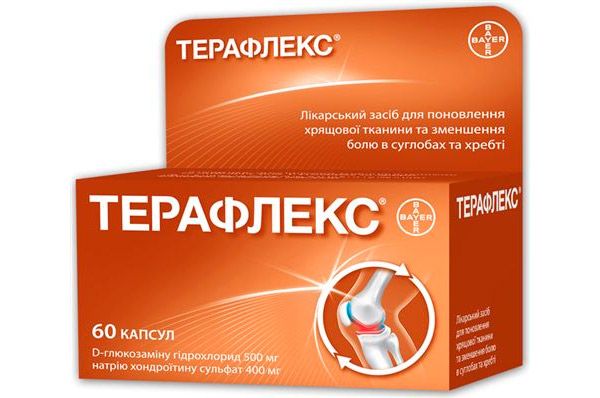
After oral administration, it is rapidly absorbed in the gastrointestinal tract, the maximum concentration in the blood plasma is reached after 3-4 hours, in the synovial fluid after 4-5 hours. About 30% of the drug penetrates the synovial membranes and cartilage. It is biotransformed in the liver and excreted by the kidneys within 24 hours.
- Indications for use: complex treatment of musculoskeletal disorders with degenerative-dystrophic changes in joint tissue. Prescribed for knee injuries, traumatic bone lesions, spinal osteochondrosis, primary and secondary osteoarthrosis. Not used in case of intolerance to the components, during pregnancy and breastfeeding, and phenylketonuria.
- Method of administration: the medicine is taken by all patients over the age of 12. Patients are prescribed 1 capsule 3 times a day from the 1st to the 21st day of therapy, and then 1 capsule 2 times a day. The course of treatment should last at least 2 months. For complete recovery, several courses are carried out with an interval of 3 months.
- Side effects are rare and usually include dyspepsia or skin allergic soup. To date, no cases of overdose have been reported, but symptomatic therapy is necessary when using high doses. There is no specific antidote.
Method of administration and dosage of tablets for knee pain
To achieve the desired therapeutic result, the doctor selects not only the drug, but also the method of its use. The doses of tablets for knee pain depend on their cause, the severity of the pain syndrome, the patient's age and the individual characteristics of his body.
As a rule, patients are prescribed 1-3 doses of the drug per day, the dosage can be calculated as mg/kg of body weight. Some medications (narcotic analgesics, opioids) are taken in short courses to prevent addiction and withdrawal syndrome. The duration of therapy with chondroprotectors can be from 3-6 months with subsequent repeated courses. The duration of treatment with other groups of drugs depends on the results obtained in the first days of use.
Using Knee Pain Pills During Pregnancy
No one is immune from injuries and joint pain. Thus, during pregnancy, due to increased stress on the body, many women experience knee pain. To eliminate them, drugs of varying effectiveness and release form are used. The use of tablets for knee pain during pregnancy is possible only with the appropriate doctor's permission.
The use of non-steroidal anti-inflammatory drugs such as Ibuprofen, Diclofenac, Indomethacin or Paracetamol is possible only with a doctor's prescription. Non-narcotic analgesics, chondroprotectors and opioids are taken by prescription. Narcotic painkillers are contraindicated, since, despite the strong analgesic effect, they penetrate into all biological fluids, which negatively affects the development of the fetus. Most often, women are prescribed local painkillers - ointments, creams, gels.
Contraindications for use
Medicines for eliminating joint pain, like other medications, have certain contraindications for use. Let's consider them using the example of popular tablets prescribed for painful sensations in the knees:
- NSAIDs
Do not use in case of erosive and ulcerative lesions of the gastrointestinal tract, hematopoietic disorders, hypersensitivity to the components of the drug, for patients under 6 years of age.
- Non-narcotic analgesics
Individual intolerance to active components, allergy to NSAIDs, hemorrhagic diathesis, impaired renal and hepatic function, hemorrhagic stroke, acute ulcers of the duodenum and stomach, bronchial asthma.
- Narcotic analgesics
Hypersensitivity, blood clotting disorders, intestinal obstruction, respiratory depression. Pregnancy and lactation period, for elderly and pediatric patients.
- Opioid
Alcohol or drug intoxication, traumatic brain injury, epilepsy, severe renal and hepatic failure, opiate intolerance, pregnancy and childhood.
- Chondroprotectors
Tendency to bleeding, pregnancy, lactation, elderly patients.
Side effects of knee pain pills
Regardless of the pharmacological group, the side effects of knee pain pills have similar symptoms:
- Nausea, vomiting, diarrhea/constipation.
- Headaches and dizziness.
- Sleep disturbances, increased excitability.
- Decreased visual and hearing acuity.
- Increased sweating.
- Disorders of the genitourinary system.
- Increased blood pressure and increased heart rate.
- Skin allergic reactions.
- Depression of the respiratory center, bronchospasms.
To eliminate them, in most cases, symptomatic therapy and mandatory consultation with the attending physician are indicated.
Overdose
Exceeding the dosage prescribed by the doctor or long-term use of the drug can cause adverse symptoms in many organs and systems. Overdose is similar to side effects. Most often, patients experience:
- Stomach ache.
- Nausea, vomiting
- Drowsiness.
- Headaches.
- Tinnitus.
- Tachycardia.
- Increased sweating.
- Confusion of consciousness.
- Cramps.
- Low blood pressure and other symptoms.
Symptomatic therapy is indicated to eliminate them. First of all, this is gastric lavage and taking activated carbon to reduce the absorption of the active components of the drug. After this, you must seek medical help to adjust the dose or prescribe another drug.
Interactions with other drugs
A comprehensive approach is used in the treatment of any disease. This implies interactions with other drugs to restore health. Let's consider the possibility of simultaneous use of different groups of drugs with tablets for the treatment of knee damage:
- NSAIDs – Ibuprofen reduces the diuretic effect of Furosemide, enhances the effect of oral hypoglycemic agents, Diphenin and coumarin anticoagulants.
- Non-narcotic analgesics - Xefocam increases the risk of bleeding when used with anticoagulants and aggregation inhibitors. Potentiates the action of sulfonylurea derivatives. In combination with NSAIDs, it increases the risk of side effects from the gastrointestinal tract.
- Narcotic analgesics – Morphine enhances the effect of sedatives and local anesthetics. The analgesic effect is reduced with the systematic use of barbiturates, especially Phenobarbital.
- Opioids – the use of different drugs from this group increases the effectiveness of each. Psychostimulants and analeptics reduce the analgesic effect. When taken with antidepressants, synergism is observed.
Storage conditions
To preserve the medicinal properties of the tablets throughout their shelf life, it is necessary to observe the storage conditions. It is recommended to keep the tablet forms in the original packaging, in a place protected from light and moisture.
The storage place should be inaccessible to children and sunlight. The recommended temperature is no higher than 25°C. Failure to comply with these conditions leads to premature deterioration of the medicine.
Best before date
Knee pain pills have an expiration date during which they must be used. It varies for different pharmacological groups, usually from 3 to 5 years, provided that storage rules are followed. After this time, the drug must be disposed of. Taking unopened but expired medications is contraindicated.
Attention!
To simplify the perception of information, this instruction for use of the drug "Knee pain pills" translated and presented in a special form on the basis of the official instructions for medical use of the drug. Before use read the annotation that came directly to medicines.
Description provided for informational purposes and is not a guide to self-healing. The need for this drug, the purpose of the treatment regimen, methods and dose of the drug is determined solely by the attending physician. Self-medication is dangerous for your health.

